Abstract
OBJECTIVE: The authors tested the hypothesis that the beneficial effects of the endotoxin-binding agent cholestyramine on the postoperative course in rats that had undergone a partial hepatectomy was the result of improvement of cellular immune functions. SUMMARY BACKGROUND DATA: Major liver resection is associated with severe postoperative complications and a high incidence of systemic infections. Gut-derived endotoxins previously were shown to be involved in the pathogenic processes after partial hepatectomy in rats. In addition, enteral cholestyramine improved postoperative survival, but how its beneficial effects are mediated is not clear. METHODS: Rats that were force-fed for 7 days with either cholestyramine (150 mg/day) or 0.9% saline (equal volume) were randomized to undergo a partial hepatectomy or a sham operation. After 24 hours, the rats were killed and splenic mononuclear cells were tested in vitro for mitogenic responses and cytokine production. RESULTS: Proliferative responses of splenic B and T lymphocytes and lipopolysaccharide-stimulated production of tumor necrosis factor and interleukin-1 by splenocytes were lower in rats after partial hepatectomy than in sham-operated animals. An increased concanavalin A-stimulated production of interleukin-2 also was found after partial hepatectomy compared with sham levels. Pretreatment with enteral cholestyramine preserved cellular proliferative responsiveness of both B and T cells, and restored cytokine production by splenocytes to sham levels. CONCLUSION: Prophylactic treatment with enteral cholestyramine preserved cellular immune functions after partial hepatectomy in the rat, which may explain its beneficial effects on the postoperative course. Furthermore, the authors' results are consistent with the hypothesis that endotoxemia is involved in the pathogenesis of the cellular immune derangements after partial hepatectomy.
Full text
PDF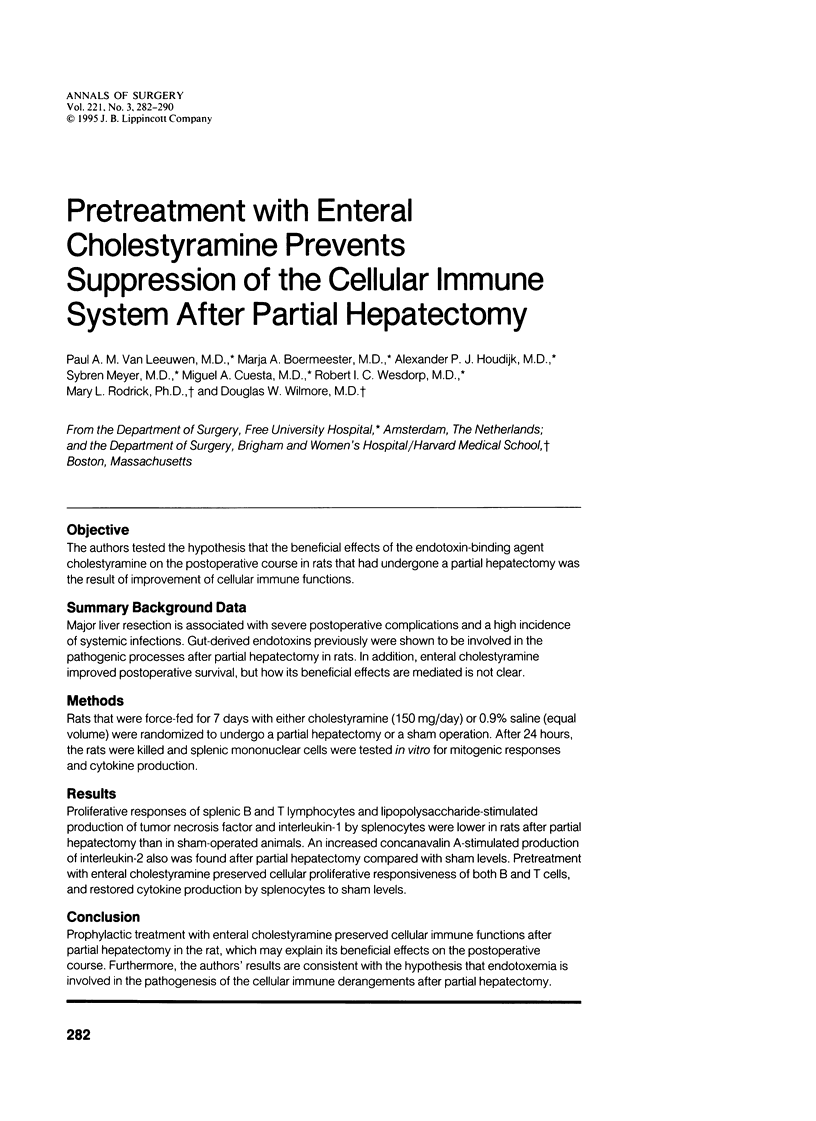
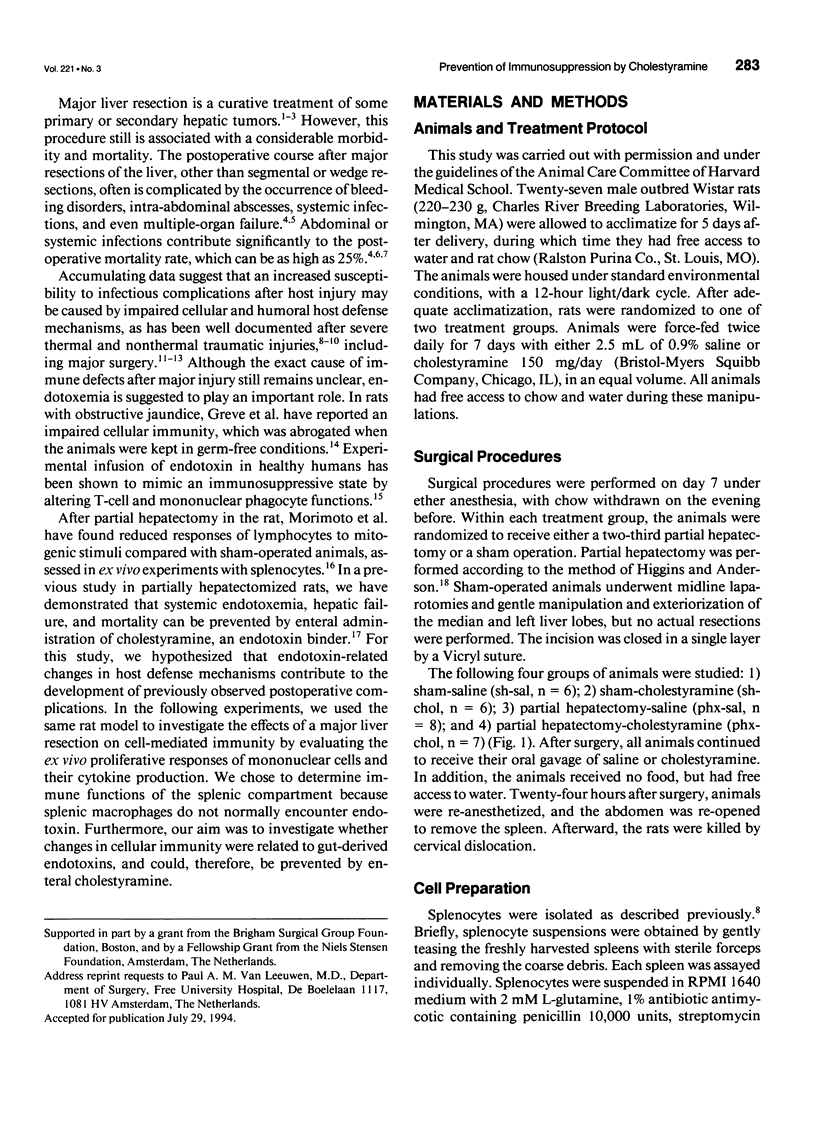
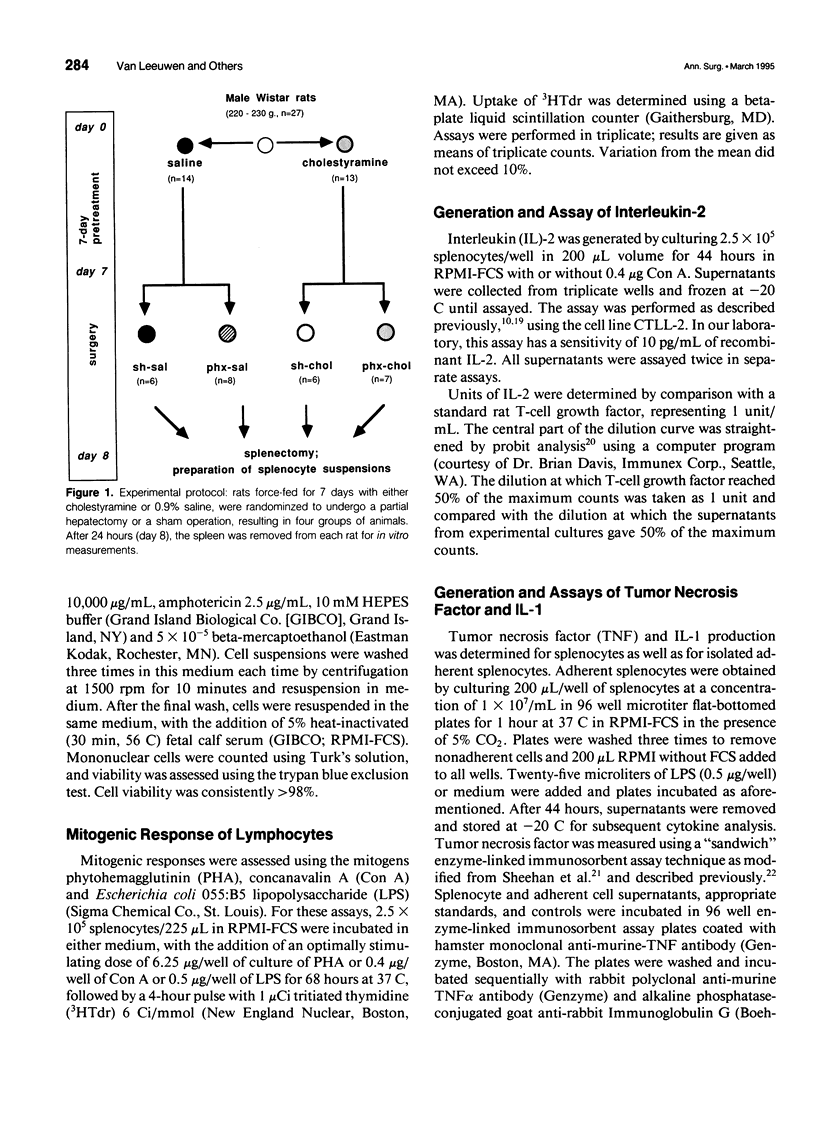
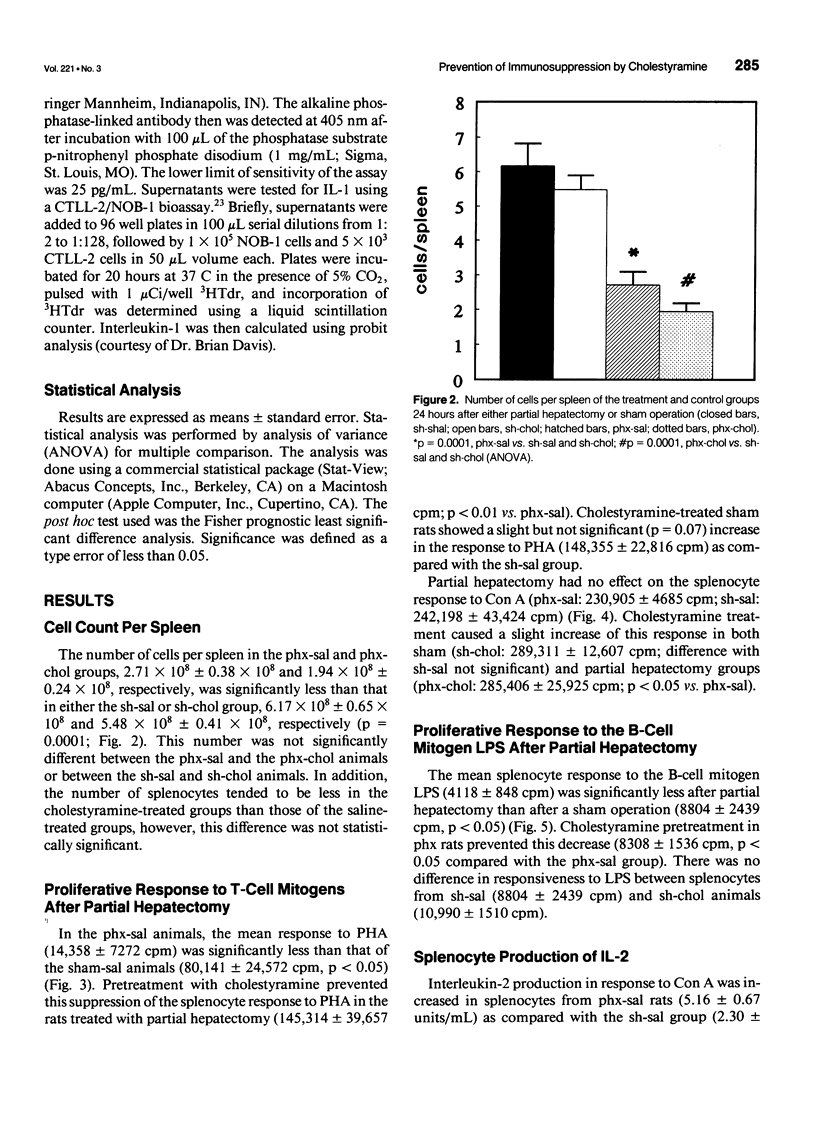
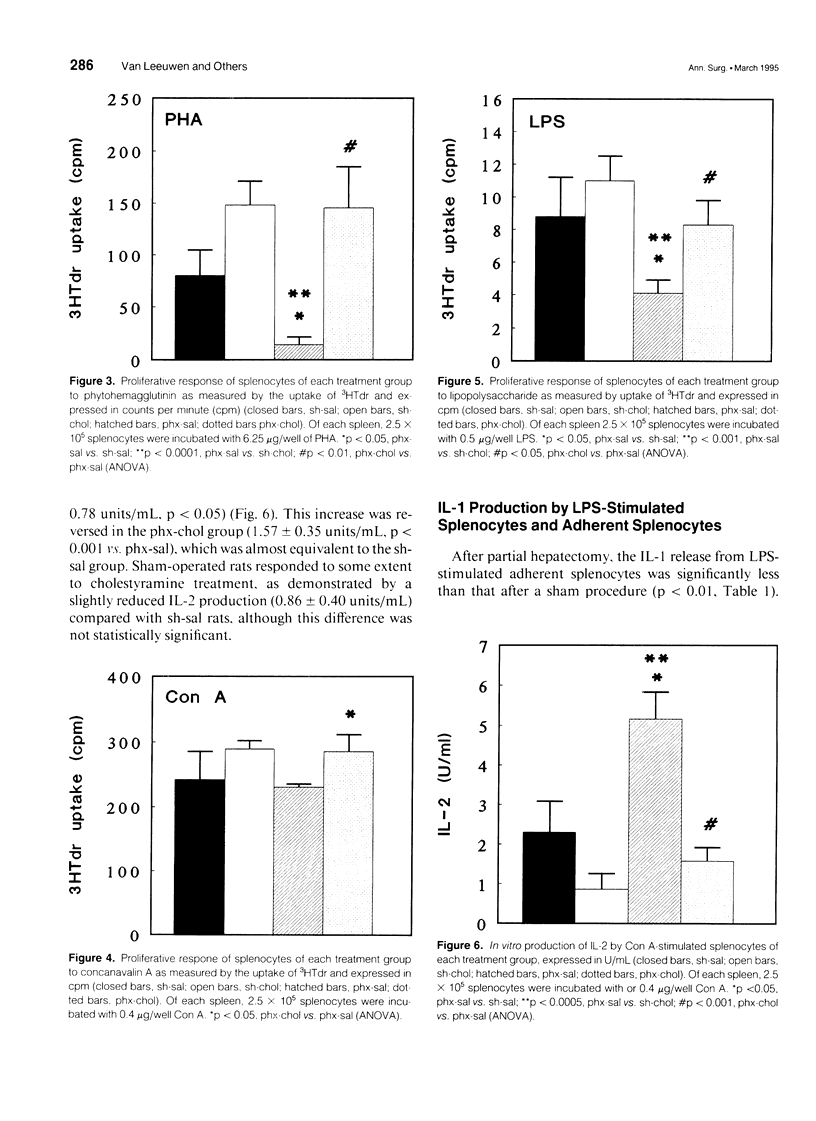
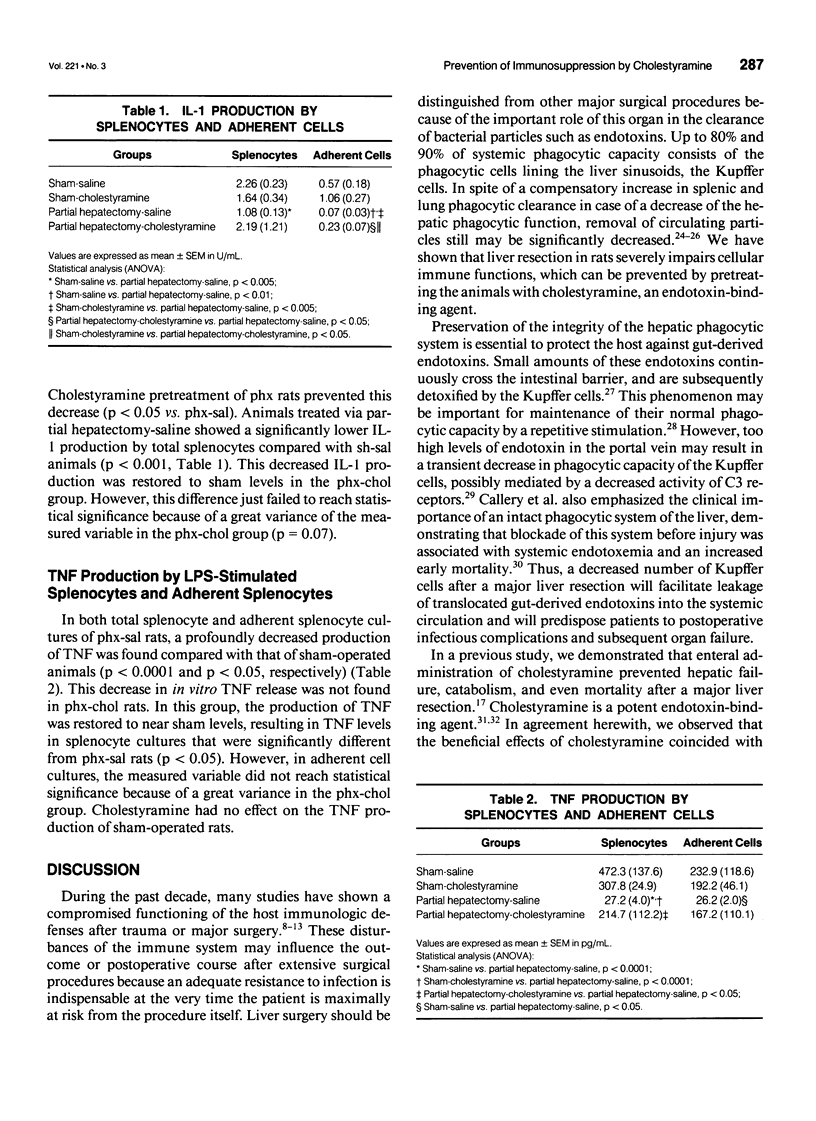
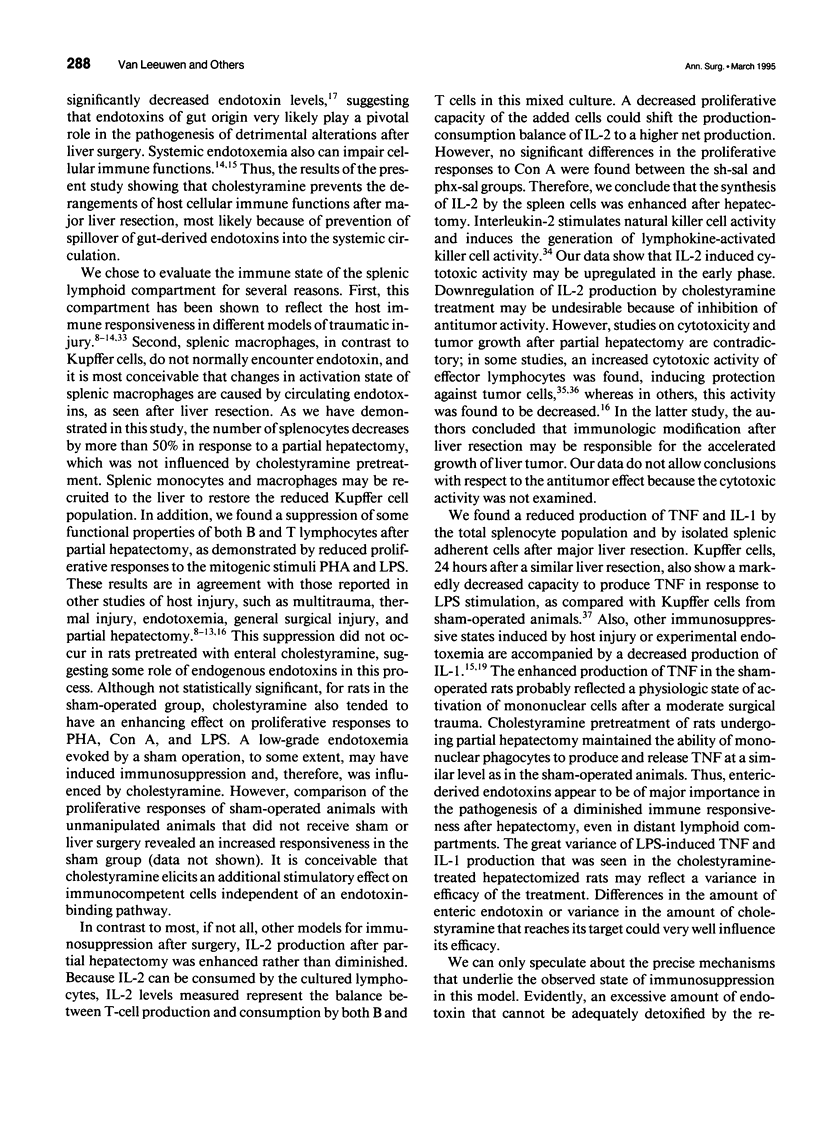
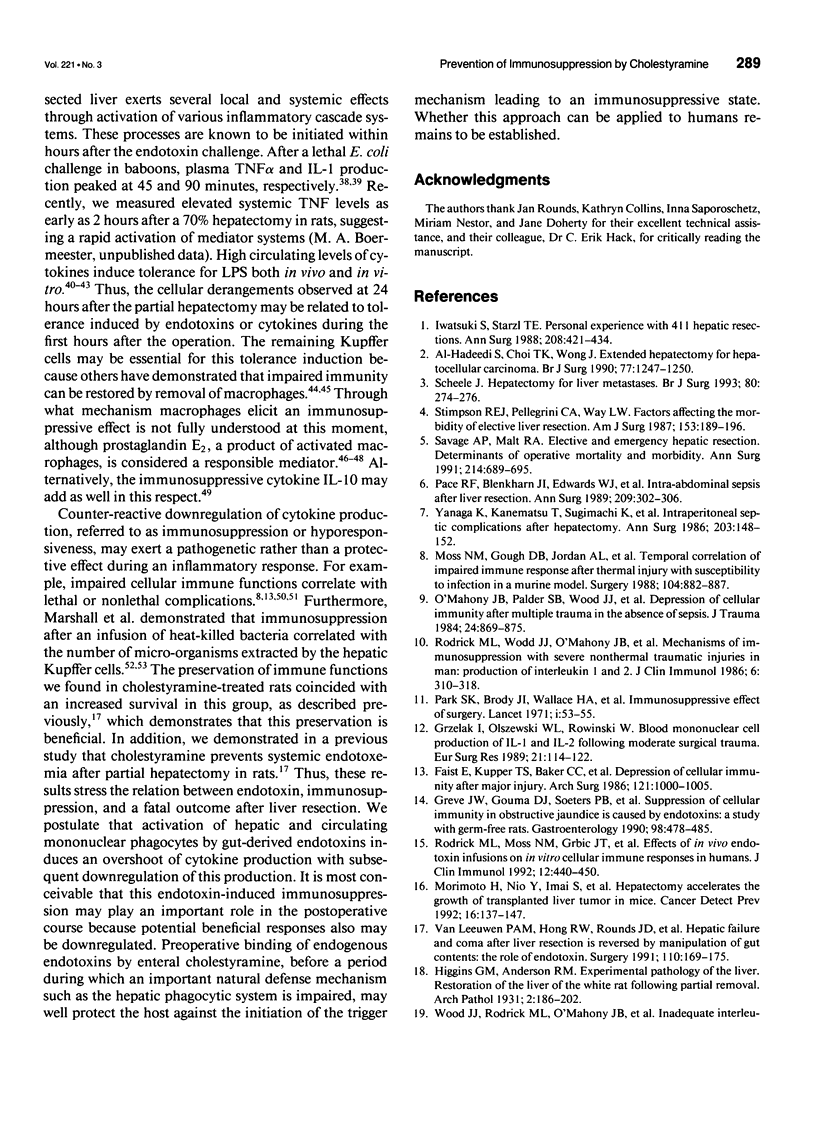
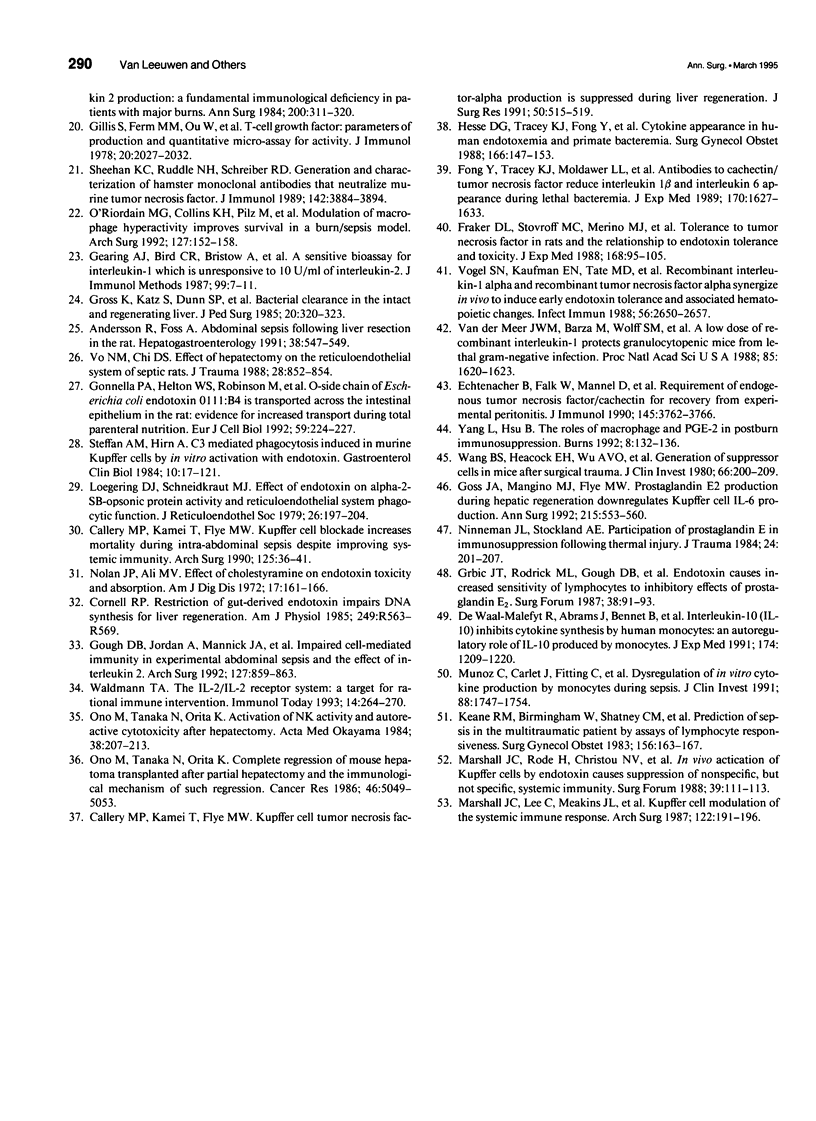
Selected References
These references are in PubMed. This may not be the complete list of references from this article.
- Andersson R., Foss A. Abdominal sepsis following liver resection in the rat. Hepatogastroenterology. 1991 Dec;38(6):547–549. [PubMed] [Google Scholar]
- Callery M. P., Kamei T., Flye M. W. Kupffer cell blockade increases mortality during intra-abdominal sepsis despite improving systemic immunity. Arch Surg. 1990 Jan;125(1):36–41. doi: 10.1001/archsurg.1990.01410130038005. [DOI] [PubMed] [Google Scholar]
- Callery M. P., Kamei T., Flye M. W. Kupffer cell tumor necrosis factor-alpha production is suppressed during liver regeneration. J Surg Res. 1991 May;50(5):515–519. doi: 10.1016/0022-4804(91)90034-j. [DOI] [PubMed] [Google Scholar]
- Cornell R. P. Restriction of gut-derived endotoxin impairs DNA synthesis for liver regeneration. Am J Physiol. 1985 Nov;249(5 Pt 2):R563–R569. doi: 10.1152/ajpregu.1985.249.5.R563. [DOI] [PubMed] [Google Scholar]
- Echtenacher B., Falk W., Männel D. N., Krammer P. H. Requirement of endogenous tumor necrosis factor/cachectin for recovery from experimental peritonitis. J Immunol. 1990 Dec 1;145(11):3762–3766. [PubMed] [Google Scholar]
- Faist E., Kupper T. S., Baker C. C., Chaudry I. H., Dwyer J., Baue A. E. Depression of cellular immunity after major injury. Its association with posttraumatic complications and its reversal with immunomodulation. Arch Surg. 1986 Sep;121(9):1000–1005. doi: 10.1001/archsurg.1986.01400090026004. [DOI] [PubMed] [Google Scholar]
- Fong Y., Tracey K. J., Moldawer L. L., Hesse D. G., Manogue K. B., Kenney J. S., Lee A. T., Kuo G. C., Allison A. C., Lowry S. F. Antibodies to cachectin/tumor necrosis factor reduce interleukin 1 beta and interleukin 6 appearance during lethal bacteremia. J Exp Med. 1989 Nov 1;170(5):1627–1633. doi: 10.1084/jem.170.5.1627. [DOI] [PMC free article] [PubMed] [Google Scholar]
- Fraker D. L., Stovroff M. C., Merino M. J., Norton J. A. Tolerance to tumor necrosis factor in rats and the relationship to endotoxin tolerance and toxicity. J Exp Med. 1988 Jul 1;168(1):95–105. doi: 10.1084/jem.168.1.95. [DOI] [PMC free article] [PubMed] [Google Scholar]
- Gearing A. J., Bird C. R., Bristow A., Poole S., Thorpe R. A simple sensitive bioassay for interleukin-1 which is unresponsive to 10(3) U/ml of interleukin-2. J Immunol Methods. 1987 May 4;99(1):7–11. doi: 10.1016/0022-1759(87)90025-1. [DOI] [PubMed] [Google Scholar]
- Gillis S., Ferm M. M., Ou W., Smith K. A. T cell growth factor: parameters of production and a quantitative microassay for activity. J Immunol. 1978 Jun;120(6):2027–2032. [PubMed] [Google Scholar]
- Gonnella P. A., Helton W. S., Robinson M., Wilmore D. W. O-side chain of Escherichia coli endotoxin 0111:B4 is transported across the intestinal epithelium in the rat: evidence for increased transport during total parenteral nutrition. Eur J Cell Biol. 1992 Oct;59(1):224–227. [PubMed] [Google Scholar]
- Goss J. A., Mangino M. J., Flye M. W. Prostaglandin E2 production during hepatic regeneration downregulates Kupffer cell IL-6 production. Ann Surg. 1992 Jun;215(6):553–560. [PMC free article] [PubMed] [Google Scholar]
- Gough D. B., Jordan A., Mannick J. A., Rodrick M. I. Impaired cell-mediated immunity in experimental abdominal sepsis and the effect of interleukin 2. Arch Surg. 1992 Jul;127(7):859–863. doi: 10.1001/archsurg.1992.01420070123022. [DOI] [PubMed] [Google Scholar]
- Greve J. W., Gouma D. J., Soeters P. B., Buurman W. A. Suppression of cellular immunity in obstructive jaundice is caused by endotoxins: a study with germ-free rats. Gastroenterology. 1990 Feb;98(2):478–485. doi: 10.1016/0016-5085(90)90841-n. [DOI] [PubMed] [Google Scholar]
- Gross K., Katz S., Dunn S. P., Cikrit D., Rosenthal R., Grosfeld J. L. Bacterial clearance in the intact and regenerating liver. J Pediatr Surg. 1985 Aug;20(4):320–323. doi: 10.1016/s0022-3468(85)80211-6. [DOI] [PubMed] [Google Scholar]
- Grzelak I., Olszewski W. L., Rowinski W. Blood mononuclear cell production of IL-1 and IL-2 following moderate surgical trauma. Eur Surg Res. 1989;21(2):114–122. doi: 10.1159/000129011. [DOI] [PubMed] [Google Scholar]
- Hesse D. G., Tracey K. J., Fong Y., Manogue K. R., Palladino M. A., Jr, Cerami A., Shires G. T., Lowry S. F. Cytokine appearance in human endotoxemia and primate bacteremia. Surg Gynecol Obstet. 1988 Feb;166(2):147–153. [PubMed] [Google Scholar]
- Iwatsuki S., Starzl T. E. Personal experience with 411 hepatic resections. Ann Surg. 1988 Oct;208(4):421–434. doi: 10.1097/00000658-198810000-00004. [DOI] [PMC free article] [PubMed] [Google Scholar]
- Keane R. M., Birmingham W., Shatney C. M., Winchurch R. A., Munster A. M. Prediction of sepsis in the multitraumatic patient by assays of lymphocyte responsiveness. Surg Gynecol Obstet. 1983 Feb;156(2):163–167. [PubMed] [Google Scholar]
- Loegering D. J., Schneidkraut M. J. Effect of endotoxin on alpha 2 SB-opsonic protein activity and reticuloendothelial system phagocytic function. J Reticuloendothel Soc. 1979 Aug;26(2):197–204. [PubMed] [Google Scholar]
- Marshall J. C., Lee C., Meakins J. L., Michel R. P., Christou N. V. Kupffer cell modulation of the systemic immune response. Arch Surg. 1987 Feb;122(2):191–196. doi: 10.1001/archsurg.1987.01400140073009. [DOI] [PubMed] [Google Scholar]
- Morimoto H., Nio Y., Imai S., Shiraishi T., Tsubono M., Tseng C. C., Tobe T. Hepatectomy accelerates the growth of transplanted liver tumor in mice. Cancer Detect Prev. 1992;16(2):137–147. [PubMed] [Google Scholar]
- Moss N. M., Gough D. B., Jordan A. L., Grbic J. T., Wood J. J., Rodrick M. L., Mannick J. A. Temporal correlation of impaired immune response after thermal injury with susceptibility to infection in a murine model. Surgery. 1988 Nov;104(5):882–887. [PubMed] [Google Scholar]
- Munoz C., Carlet J., Fitting C., Misset B., Blériot J. P., Cavaillon J. M. Dysregulation of in vitro cytokine production by monocytes during sepsis. J Clin Invest. 1991 Nov;88(5):1747–1754. doi: 10.1172/JCI115493. [DOI] [PMC free article] [PubMed] [Google Scholar]
- Ninnemann J. L., Stockland A. E. Participation of prostaglandin E in immunosuppression following thermal injury. J Trauma. 1984 Mar;24(3):201–207. doi: 10.1097/00005373-198403000-00003. [DOI] [PubMed] [Google Scholar]
- Nolan J. P., Ali M. V. Effect of cholestyramine on endotoxin toxicity and absorption. Am J Dig Dis. 1972 Feb;17(2):161–166. doi: 10.1007/BF02232738. [DOI] [PubMed] [Google Scholar]
- O'Mahony J. B., Palder S. B., Wood J. J., McIrvine A., Rodrick M. L., Demling R. H., Mannick J. A. Depression of cellular immunity after multiple trauma in the absence of sepsis. J Trauma. 1984 Oct;24(10):869–875. doi: 10.1097/00005373-198410000-00001. [DOI] [PubMed] [Google Scholar]
- O'Riordain M. G., Collins K. H., Pilz M., Saporoschetz I. B., Mannick J. A., Rodrick M. L. Modulation of macrophage hyperactivity improves survival in a burn-sepsis model. Arch Surg. 1992 Feb;127(2):152–158. doi: 10.1001/archsurg.1992.01420020034005. [DOI] [PubMed] [Google Scholar]
- Ono M., Tanaka N., Orita K. Activation of NK activity and auto-reactive cytotoxicity after hepatectomy. Acta Med Okayama. 1984 Apr;38(2):207–213. doi: 10.18926/AMO/30329. [DOI] [PubMed] [Google Scholar]
- Ono M., Tanaka N., Orita K. Complete regression of mouse hepatoma transplanted after partial hepatectomy and the immunological mechanism of such regression. Cancer Res. 1986 Oct;46(10):5049–5053. [PubMed] [Google Scholar]
- Pace R. F., Blenkharn J. I., Edwards W. J., Orloff M., Blumgart L. H., Benjamin I. S. Intra-abdominal sepsis after hepatic resection. Ann Surg. 1989 Mar;209(3):302–306. doi: 10.1097/00000658-198903000-00009. [DOI] [PMC free article] [PubMed] [Google Scholar]
- Park S. K., Brody J. I., Wallace H. A., Blakemore W. S. Immunosuppressive effect of surgery. Lancet. 1971 Jan 9;1(7689):53–55. doi: 10.1016/s0140-6736(71)90777-x. [DOI] [PubMed] [Google Scholar]
- Rodrick M. L., Moss N. M., Grbic J. T., Revhaug A., O'Dwyer S. T., Michie H. R., Gough D. B., Dubravec D., Manson J. M., Saporoschetz I. B. Effects of in vivo endotoxin infusions on in vitro cellular immune responses in humans. J Clin Immunol. 1992 Nov;12(6):440–450. doi: 10.1007/BF00918856. [DOI] [PubMed] [Google Scholar]
- Rodrick M. L., Wood J. J., O'Mahony J. B., Davis C. F., Grbic J. T., Demling R. H., Moss N. M., Saporoschetz I., Jordan A., D'Eon P. Mechanisms of immunosuppression associated with severe nonthermal traumatic injuries in man: production of interleukin 1 and 2. J Clin Immunol. 1986 Jul;6(4):310–318. doi: 10.1007/BF00917332. [DOI] [PubMed] [Google Scholar]
- Savage A. P., Malt R. A. Elective and emergency hepatic resection. Determinants of operative mortality and morbidity. Ann Surg. 1991 Dec;214(6):689–695. doi: 10.1097/00000658-199112000-00008. [DOI] [PMC free article] [PubMed] [Google Scholar]
- Scheele J. Hepatectomy for liver metastases. Br J Surg. 1993 Mar;80(3):274–276. doi: 10.1002/bjs.1800800302. [DOI] [PubMed] [Google Scholar]
- Sheehan K. C., Ruddle N. H., Schreiber R. D. Generation and characterization of hamster monoclonal antibodies that neutralize murine tumor necrosis factors. J Immunol. 1989 Jun 1;142(11):3884–3893. [PubMed] [Google Scholar]
- Steffan A. M., Kirn A. C3-mediated phagocytosis induced in murine Kupffer cells by "in vitro" activation with endotoxin. Gastroenterol Clin Biol. 1986 Feb;10(2):117–121. [PubMed] [Google Scholar]
- Stimpson R. E., Pellegrini C. A., Way L. W. Factors affecting the morbidity of elective liver resection. Am J Surg. 1987 Feb;153(2):189–196. doi: 10.1016/0002-9610(87)90812-9. [DOI] [PubMed] [Google Scholar]
- Vo N. M., Chi D. S. Effect of hepatectomy on the reticuloendothelial system of septic rats. J Trauma. 1988 Jun;28(6):852–854. doi: 10.1097/00005373-198806000-00025. [DOI] [PubMed] [Google Scholar]
- Vogel S. N., Kaufman E. N., Tate M. D., Neta R. Recombinant interleukin-1 alpha and recombinant tumor necrosis factor alpha synergize in vivo to induce early endotoxin tolerance and associated hematopoietic changes. Infect Immun. 1988 Oct;56(10):2650–2657. doi: 10.1128/iai.56.10.2650-2657.1988. [DOI] [PMC free article] [PubMed] [Google Scholar]
- Waldmann T. A. The IL-2/IL-2 receptor system: a target for rational immune intervention. Immunol Today. 1993 Jun;14(6):264–270. doi: 10.1016/0167-5699(93)90043-K. [DOI] [PubMed] [Google Scholar]
- Wang B. S., Heacock E. H., Wu A. V., Mannick J. A. Generation of suppressor cells in mice after surgical trauma. J Clin Invest. 1980 Aug;66(2):200–209. doi: 10.1172/JCI109845. [DOI] [PMC free article] [PubMed] [Google Scholar]
- Wood J. J., Rodrick M. L., O'Mahony J. B., Palder S. B., Saporoschetz I., D'Eon P., Mannick J. A. Inadequate interleukin 2 production. A fundamental immunological deficiency in patients with major burns. Ann Surg. 1984 Sep;200(3):311–320. doi: 10.1097/00000658-198409000-00008. [DOI] [PMC free article] [PubMed] [Google Scholar]
- Yanaga K., Kanematsu T., Takenaka K., Sugimachi K. Intraperitoneal septic complications after hepatectomy. Ann Surg. 1986 Feb;203(2):148–152. doi: 10.1097/00000658-198602000-00007. [DOI] [PMC free article] [PubMed] [Google Scholar]
- Yang L., Hsu B. The roles of macrophage (M phi) and PGE-2 in postburn immunosuppression. Burns. 1992 Apr;18(2):132–136. doi: 10.1016/0305-4179(92)90010-r. [DOI] [PubMed] [Google Scholar]
- al-Hadeedi S., Choi T. K., Wong J. Extended hepatectomy for hepatocellular carcinoma. Br J Surg. 1990 Nov;77(11):1247–1250. doi: 10.1002/bjs.1800771116. [DOI] [PubMed] [Google Scholar]
- de Waal Malefyt R., Abrams J., Bennett B., Figdor C. G., de Vries J. E. Interleukin 10(IL-10) inhibits cytokine synthesis by human monocytes: an autoregulatory role of IL-10 produced by monocytes. J Exp Med. 1991 Nov 1;174(5):1209–1220. doi: 10.1084/jem.174.5.1209. [DOI] [PMC free article] [PubMed] [Google Scholar]
- van Leeuwen P. A., Hong R. W., Rounds J. D., Rodrick M. L., Wilmore D. Hepatic failure and coma after liver resection is reversed by manipulation of gut contents: the role of endotoxin. Surgery. 1991 Aug;110(2):169–175. doi: 10.1016/0261-5614(91)90171-8. [DOI] [PubMed] [Google Scholar]
- van der Meer J. W., Barza M., Wolff S. M., Dinarello C. A. A low dose of recombinant interleukin 1 protects granulocytopenic mice from lethal gram-negative infection. Proc Natl Acad Sci U S A. 1988 Mar;85(5):1620–1623. doi: 10.1073/pnas.85.5.1620. [DOI] [PMC free article] [PubMed] [Google Scholar]


